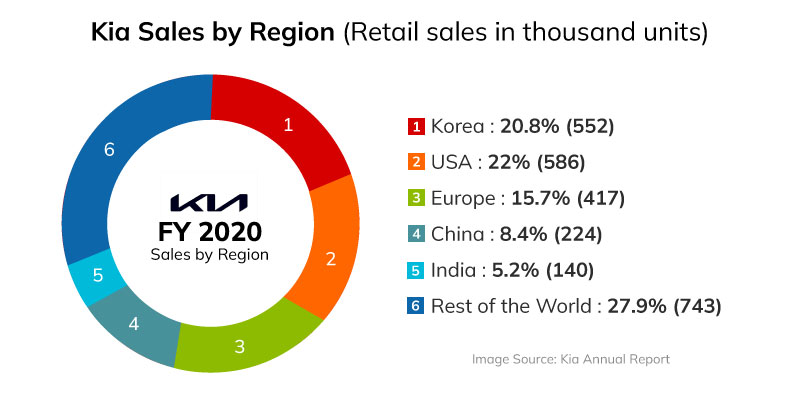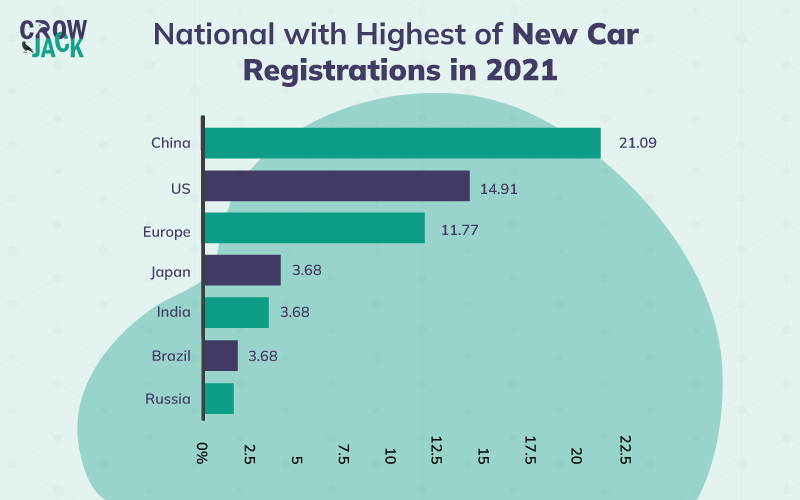Kia Overview
This article analyzes the macro environment in the global automotive industry with respect to Kia, the popular car manufacturing MNC originally based in South Korea. The PESTLE Analysis model has been implemented to explain how external business factors affect the ongoing operations and future priorities of Kia.
To elaborate, the PESTLE Analysis Model will evaluate the political, economic, social, technological, legal, and environmental factors shaping the current trends in the automotive industry. Further, the key determinants identified in the classification of PESTLE factors will have a direct impact on the global automotive industry and hence, Kia.
Table of Contents
Furthermore, an in-depth understanding of PESTLE Analysis will give you a detailed overview of the most important factors in the macro business environment that directly or indirectly impact the operations and growth prospects of a company in a specific industry. As for now, let us get started with the PESTLE Analysis of Kia.
A definite PESTLE Analysis of Kia
Political factors affecting Kia
The global automotive industry largely depends on free trade agreements as automotive companies usually have their manufacturing and assembling units in different nations. The government in South Korea has 17 Free Trade Agreements that include trade partnerships with ASEAN nations, developed nations like the United States, the United Kingdom, and European Union countries. Moreover, the country also has Free Trade Agreements with emerging countries inclusive of China, Turkey, India etcetera ("South Korea - Trade Agreements", 2022). Hence, the given geopolitical scenario is positively poised for the automotive industry to flourish in emerging markets like China and India.
However, for US-based automotive manufacturers, the ongoing US-China trade rift can be a huge roadblock in capturing the Asian markets. Also, the industry is now swiftly moving towards increased production of electric vehicles as electric vehicles are being described as the future of the automotive and transportation industry. However, large import duty on electric vehicles in emerging markets like India is another cause of concern for automotive manufacturers looking to acquire new customers with EV options. The import duties in India for electric vehicles are in the range of 15 to 30 percent. High import duties in emerging markets like India can be a concern for the industry.
Also, the current political tension between Russia and Ukraine can turn out to be a negative development for the industry. To explain, in case the war breaks out, it would have a massive impact on the global geopolitical scenario and global economies may witness a massive downfall.
Economic factors affecting Kia

The global economies are on the path to recovery after the adverse economic effects of the COVID-19 pandemic. The global economy is anticipated to grow at 4.4 percent in 2022 as per the International Monetary Fund and this projection is slightly on the lower side primarily due to supply shortages. Furthermore, the global inflation rate forecast for the year 2022 is 3.8 percent and is expected to stay in the same range for the coming years ("Global inflation rate 2014-2024 | Statista", 2022). To add, the global automotive industry is expected to register a CAGR of 4.5 percent and grow in terms of 205 million additional units by 2028. For the automotive industry, the trends with respect to industry growth are favorable.
Probing further, the economy of South Korea grew by 4 percent in 2021 despite the aftermath of the COVID-19 pandemic. In 2021, the country’s GDP reached an 11 year high due to a massive surge in exports ("South Korea’s GDP growth hits 11-year high as exports boom", 2022). This is a very reassuring and optimistic sign for the automotive industry in the country looking to optimize production capacities and exports to emerging markets with the highest demand for vehicles.
The largest market for the automotive industry in terms of new vehicle registrations is China accounting for more than 21 million units in 2021. Besides China, the US, Europe, Japan, India, Brazil, and Russia are among the largest automobile markets ("Largest automobile markets worldwide - new car registrations 2021 | Statista", 2022).

This trend shows that emerging economies like China, India, and Brazil are serving as the largest markets for the industry, and hence the industry can explore new opportunities in these nations. The economic growth trends in these emerging markets are also favorable for the industry. To substantiate, in 2021, the real GDP of China grew at the rate of 8.1 percent ("China GDP growth rate 2011-2024 | Statista", 2022). Besides, the GDP of India is projected to grow at 6 percent in 2022 and 6.5 percent in 2023 ("India GDP Annual Growth Rate - 2021 Data - 2022 Forecast - 1951-2020 Historical", 2022).
Social factors affecting Kia
At the global level, lifestyle trends are changing positively and people are showing a greater preference for stylish and luxury cars. Furthermore, people’s inclination towards automatic cars and cars with enhanced safety features like panic braking signals, ABS, dual-front airbags etcetera is increasing. In emerging markets like India and China, the size of the automotive finance industry is increasing by leaps and bounds. To validate, the penetration rate of the Chinese Automotive Finance Industry is expected to rise 71 percent by the end of 2026 ("China Automotive Finance Industry Report, 2020-2026", 2022). This speaks for the changing perception of cars being now seen as a necessity even in the middle-income segment and the number of people taking car loans is increasing sharply.
Also, car buyers are increasingly becoming conscious of sustainability and the rising prices of petrol and diesel. Hence, they now gravitate towards electric and hybrid vehicles that help them address the issue of pollution and are cost-effective. This paradigm shift in the demand of car buyers will have a major impact on the industry.
Technological factors affecting Kia
Global spending on research and development is increasing at a rampant pace as global superpowers are committed to driving new technological innovations in every domain. Further, 10 countries account for around 80 percent of the global spending on research and development which has reached a value of more than USD 1.7 trillion. Besides, private spending on research and development is also increasing in most countries. The major focus is on clean energy investments to meet net-zero emissions targets.
To continue, South Korea spends 4.1 percent of its GDP on research and development which gives a major boost to all industries. In fact, South Korea is the top spender of research and development in terms of GDP share followed by Japan which spends 3.4 percent of its GDP on R&D("How much does your country invest in R&D?", 2022). Emerging nations like India and China are also proactively increasing their R&D spending. For the automotive industry which is hugely dependent on technological innovations, the hike in global spending on innovation is a positive development.
Moreover, the latest technologies in the automotive industry include the Internet of Vehicles, Augmented Reality, Smart Sensors, Big Data, Blockchain, Autonomous Driving Technologies, V2V (Vehicle to Vehicle), and V2I (Vehicle To Infrastructure) technologies and electrification. In the present scenario, most automotive manufacturers are working on developing refined electrification technologies to meet the high demand for effective electric engines. To elaborate, Vehicle to Grid (V2G), fast charging, wireless charging, smart charging, NanoBolt lithium tungsten batteries, gel electrolyte batteries, and zinc manganese oxide batteries are among the emerging EV technologies.
Legal factors affecting Kia
In almost every country, the automotive industry is regulated by strict norms that relate to vehicle safety standards and emissions norms. These standards have been established under the Motor Vehicles Acts applicable in almost all countries. For instance, in South Korea, the Motor Vehicle Management Act 2017 governs safety standards, rules for the testing of vehicles, management of vehicles etcetera ("Statutes of the Republic of Korea", 2022). Besides, in India, the automotive industry is regulated by the Motor Vehicles Act 1988 and the Central Motor Vehicles Rules 1989. To add, in 2021, China introduced the Regulation of Security Management of Automotive Data. This regulation requires the industry to follow new guidelines regarding the processing of automotive data ("China issued the auto data regulation impacting auto industry greatly | JD Supra", 2022). This regulation will have a direct impact on the autonomous driving industry and in an indirect way, it will affect the entire industry.
Besides, almost all nations have antitrust and anti-competitive laws that the industry needs to comply with. These laws restrict big players in the industry from exercising monopolistic control and promote fair competition in the industry.
Environmental factors affecting Kia
As stated above, there are strict regulations with respect to emission standards for automobile manufacturers in all countries. Also, the paradigm shift towards sustainability and the acute shortage of fossil fuels is setting a new environmental trend in the industry. To add, more than 190 nations are parties to the Paris Agreement which lays a legally binding framework for net-zero emissions by 2050.
Furthermore, the top five nations accounting for the most greenhouse gas emissions are China, the US, European Union, India, and Russia in descending order. In fact, China accounts for 26 percent of the global greenhouse gas emissions. China is followed by the US on the list accounting for 12.7 percent of the global emissions. However, China and India have set net-zero emissions targets for 2060 and 2070 respectively ("China's targets zero carbon as global energy transition ramps up", 2022). All these net zero emissions targets along with regulations on pollution directly impact the industry. In the coming years, automotive manufacturers will have to bring in sustainable innovations and new technologies with lower emissions to comply with international and national environmental norms.
To recapitulate, the macroenvironment is changing at a swift pace hence bringing new trends in the automotive industry. The political factors are favorable for the industry as it is supported by free trade agreements. Also, the social and economic factors are inclined towards the advancement of the industry. Besides, the global technological infrastructure is booming which is enabling new innovations in the automotive industry. However, the legal and environmental compliances are getting tougher for the industry and the automobile manufacturer will have to bring major operational and managerial changes to comply with the changing regulations. Also, to learn about the internal strengths and weaknesses of the company, you can go through our diligent SWOT analysis of Kia.
Recommended Readings
References
South Korea - Trade Agreements. (2022). Retrieved 17 February 2022, from https://www.trade.gov/country-commercial-guides/south-korea-trade-agreements#:~:text=Korea%20has%2017%20Free%20Trade,%2C%20U.S.%2C%20Turkey%20and%20Vietnam.
Global inflation rate 2014-2024 | Statista. (2022). Retrieved 19 February 2022, from https://www.statista.com/statistics/256598/global-inflation-rate-compared-to-previous-year/
South Korea’s GDP growth hits 11-year high as exports boom. (2022). Retrieved 19 February 2022, from https://www.aljazeera.com/economy/2022/1/25/south-koreas-gdp-growth-hit-11-year-high-in-2021-as-exports-boom
Largest automobile markets worldwide - new car registrations 2021 | Statista. (2022). Retrieved 19 February 2022, from https://www.statista.com/statistics/269872/largest-automobile-markets-worldwide-based-on-new-car-registrations/#:~:text=China%20is%20the%20largest%20automobile,rise%20of%20around%206.6%20percent.
China GDP growth rate 2011-2024 | Statista. (2022). Retrieved 19 February 2022, from https://www.statista.com/statistics/263616/gross-domestic-product-gdp-growth-rate-in-china/
India GDP Annual Growth Rate - 2021 Data - 2022 Forecast - 1951-2020 Historical. (2022). Retrieved 19 February 2022, from https://tradingeconomics.com/india/gdp-growth-annual
China Automotive Finance Industry Report, 2020-2026. (2022). Retrieved 19 February 2022, from https://www.globenewswire.com/news-release/2020/09/08/2090344/0/en/China-Automotive-Finance-Industry-Report-2020-2026.html
China Automotive Finance Industry Report, 2020-2026. (2022). Retrieved 19 February 2022, from https://www.globenewswire.com/news-release/2020/09/08/2090344/0/en/China-Automotive-Finance-Industry-Report-2020-2026.html
Statutes of the Republic of Korea. (2022). Retrieved 21 February 2022, from https://elaw.klri.re.kr/eng_service/lawView.do?hseq=42015&lang=ENG
China issued the auto data regulation impacting auto industry greatly | JD Supra. (2022). Retrieved 21 February 2022, from https://www.jdsupra.com/legalnews/china-issued-the-auto-data-regulation-4766436/#:~:text=China%20issued%20the%20Regulation%20on,the%20processing%20of%20automobile%20data
China's targets zero carbon as global energy transition ramps up. (2022). Retrieved 21 February 2022, from https://www.spglobal.com/platts/en/market-insights/blogs/energy-transition/121020-china-zero-carbon-target-2060-emissions-fossil-fuels

 Proof Reading
Proof Reading  Copy Writing
Copy Writing  Resume Writing
Resume Writing  Blogs
Blogs Guides
Guides SOP's
SOP's Student Resources
Student Resources Research Topics
Research Topics Login
Login Register
Register



